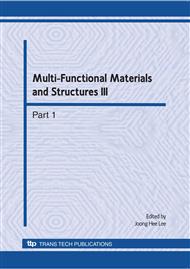[1]
M. Huang, S. Mao, H. Yan, Y. Wu, H. Kind, E. Weber, R. Russo and P. Yang: Science Vol. 292 (2001), p.1897.
Google Scholar
[2]
M. Yazawa, M. Koguchi, A. Muto, M. Ozawa and K. Hiruma: Appl. Phys. Lett. Vol. 61 (1992), p. (2051).
Google Scholar
[3]
Y. C. Choi, W. S. Kim, Y. S. Park, S. M. Lee, D. J. Bae, Y. H. Lee, G. -S. Park, W. B. Choi, N. S. Lee and J. M. Kim: Adv. Mater. Vol. 12 (2000), p.746.
DOI: 10.1002/(sici)1521-4095(200005)12:10<746::aid-adma746>3.0.co;2-n
Google Scholar
[4]
X. F. Duan and C. M. Lieber: Adv. Mater. Vol. 279 (2000), p.208.
Google Scholar
[5]
L. Vayssieres, K. Keis, S. E. Lindquist and A. Hagfeldt: J. Phys. Chem. B Vol. 105 (2001), p.3350.
Google Scholar
[6]
Y. C. Choi, W. S. Kim, Y. S. Park, S. M. Lee, D. J. Bae, Y. H. Lee, G. -S. Park, W. B. Choi, N. S. Lee and J. M. Kim: Adv. Mater. Vol. 12 (2000), p.746.
DOI: 10.1002/(sici)1521-4095(200005)12:10<746::aid-adma746>3.0.co;2-n
Google Scholar
[7]
Y. Li, G. W. Meng, L. D. Zhang and F. Phillipp: Appl. Phys. Lett. Vol. 76 (2000), p. (2011).
Google Scholar
[8]
X. D. Gao, X. M. Li and W. D. Yu: J. Phys. Chem. B Vol. 98 (2005), p.1155.
Google Scholar
[9]
J. D. Holmes, K. P. Johnston, R. C. Doty and B. A. Korgel: Science Vol. 287 (2000), p.1471.
Google Scholar
[10]
D. S. Boyle, K. Govender and P. O'Brien: Chem. Commun. (2002), p.80.
Google Scholar
[11]
J. M. Du, Z. M. Liu, Y. Huang, J. Y. Gao, B. H. Han, W. J. Li and G. Y. Yang: J. Cryst. Growth., Vol. 280 (2005), p.126.
Google Scholar
[12]
L. Vayssieres: Adv. Mater. Vol. 15 (2003), p.464.
Google Scholar
[13]
K. Yu, Z.G. Jin, X.X. Liu, J. Zhao and J.Y. Feng: Applied Surface Science, Vol. 253(2007), p.4072.
Google Scholar
[14]
D. S. Boyle, K. Govender and P. O'Brien: Chem. Commun. (2002), p.80.
Google Scholar
[15]
F. J. Jin, Z. Li and F. Li: J. Funct. Mater. Devices Vol. 13 (2007), p.453.
Google Scholar
[16]
N. Uekawa, R. Yamashita, Y. J. Wu and K. Kakegawa: Phys. Chem. Chem. Phys. Vol. 6 (2004), p.442.
Google Scholar


